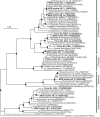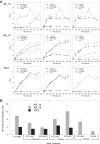Identification of Mn(II)-oxidizing bacteria from a low-pH contaminated former uranium mine
- PMID: 24928873
- PMCID: PMC4135758
- DOI: 10.1128/AEM.01296-14
Identification of Mn(II)-oxidizing bacteria from a low-pH contaminated former uranium mine
Abstract
Biological Mn oxidation is responsible for producing highly reactive and abundant Mn oxide phases in the environment that can mitigate metal contamination. However, little is known about Mn oxidation in low-pH environments, where metal contamination often is a problem as the result of mining activities. We isolated two Mn(II)-oxidizing bacteria (MOB) at pH 5.5 (Duganella isolate AB_14 and Albidiferax isolate TB-2) and nine strains at pH 7 from a former uranium mining site. Isolate TB-2 may contribute to Mn oxidation in the acidic Mn-rich subsoil, as a closely related clone represented 16% of the total community. All isolates oxidized Mn over a small pH range, and isolates from low-pH samples only oxidized Mn below pH 6. Two strains with different pH optima differed in their Fe requirements for Mn oxidation, suggesting that Mn oxidation by the strain found at neutral pH was linked to Fe oxidation. Isolates tolerated Ni, Cu, and Cd and produced Mn oxides with similarities to todorokite and birnessite, with the latter being present in subsurface layers where metal enrichment was associated with Mn oxides. This demonstrates that MOB can be involved in the formation of biogenic Mn oxides in both moderately acidic and neutral pH environments.
Copyright © 2014, American Society for Microbiology. All Rights Reserved.
Figures





Similar articles
-
Biological Low-pH Mn(II) Oxidation in a Manganese Deposit Influenced by Metal-Rich Groundwater.Appl Environ Microbiol. 2016 May 2;82(10):3009-3021. doi: 10.1128/AEM.03844-15. Print 2016 May 15. Appl Environ Microbiol. 2016. PMID: 26969702 Free PMC article.
-
Population structure of manganese-oxidizing bacteria in stratified soils and properties of manganese oxide aggregates under manganese-complex medium enrichment.PLoS One. 2013 Sep 12;8(9):e73778. doi: 10.1371/journal.pone.0073778. eCollection 2013. PLoS One. 2013. PMID: 24069232 Free PMC article.
-
[Formation and reactions of biogenic manganese oxides with heavy metals in environment].Huan Jing Ke Xue. 2009 Feb 15;30(2):574-82. Huan Jing Ke Xue. 2009. PMID: 19402518 Chinese.
-
Bacteriogenic manganese oxides.Acc Chem Res. 2010 Jan 19;43(1):2-9. doi: 10.1021/ar800232a. Acc Chem Res. 2010. PMID: 19778036 Review.
-
Dissimilatory Fe(III) and Mn(IV) reduction.Adv Microb Physiol. 2004;49:219-86. doi: 10.1016/S0065-2911(04)49005-5. Adv Microb Physiol. 2004. PMID: 15518832 Review.
Cited by
-
Draft Genome Sequence of Mn(II)-Oxidizing Bacterium Oxalobacteraceae sp. Strain AB_14.Microbiol Resour Announc. 2019 Oct 24;8(43):e01024-19. doi: 10.1128/MRA.01024-19. Microbiol Resour Announc. 2019. PMID: 31649081 Free PMC article.
-
Environmental Bacteria Involved in Manganese(II) Oxidation and Removal From Groundwater.Front Microbiol. 2019 Feb 11;10:119. doi: 10.3389/fmicb.2019.00119. eCollection 2019. Front Microbiol. 2019. PMID: 30853942 Free PMC article.
-
Characteristics of bacterial communities in rhizosphere and bulk soil in Fe-deficient citrus growing in coastal saline-alkali land.Front Plant Sci. 2024 Feb 20;14:1335843. doi: 10.3389/fpls.2023.1335843. eCollection 2023. Front Plant Sci. 2024. PMID: 38445102 Free PMC article.
-
An integrated microbiological and electrochemical approach to determine distributions of Fe metabolism in acid mine drainage-induced "iron mound" sediments.PLoS One. 2019 Mar 26;14(3):e0213807. doi: 10.1371/journal.pone.0213807. eCollection 2019. PLoS One. 2019. PMID: 30913215 Free PMC article.
-
Biogenic Mn Oxide Generation and Mn(II) Removal by a Manganese Oxidizing Bacterium Bacillus sp. Strain M2.Appl Biochem Biotechnol. 2024 Nov;196(11):8366-8380. doi: 10.1007/s12010-024-04974-8. Epub 2024 Jun 12. Appl Biochem Biotechnol. 2024. PMID: 38865070
References
-
- Morgan JJ. 2005. Kinetics of reaction between O2 and Mn(II) species in aqueous solutions. Geochim. Cosmochim. Acta 69:35–48. 10.1016/j.gca.2004.06.013 - DOI
-
- Tebo BM, Bargar JR, Clement BG, Dick GJ, Murray KJ, Parker D, Verity R, Webb SM. 2004. Biogenic manganese oxides: properties and mechanisms of formation. Annu. Rev. Earth Planet. Sci. 32:287–328. 10.1146/annurev.earth.32.101802.120213 - DOI
-
- Tebo B, Clement B, Dick G. 2007. Biotransformations of manganese, p 1223–1238 In Hurst CJ. (ed), Manual of environmental microbiology, 3rd ed. ASM Press, Washington, DC
-
- Nealson KH. 2006. The manganese-oxidizing bacteria, p 222–231 In Balows A, Trüper HG, Dworkin M, Harder W, Schleifer K-H. (ed), The prokaryotes. Springer, New York, NY
Publication types
MeSH terms
Substances
Associated data
- Actions
- Actions
- Actions
- Actions
- Actions
- Actions
- Actions
- Actions
- Actions
- Actions
- Actions
- Actions
- Actions
- Actions
- Actions
- Actions
- Actions
- Actions
- Actions
- Actions
LinkOut - more resources
Full Text Sources
Other Literature Sources
Molecular Biology Databases

